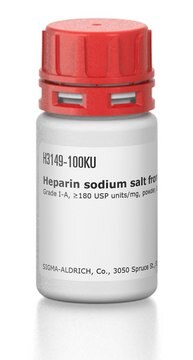推薦產品
產品名稱
甘氨酸, Vetec™, reagent grade, 98%
等級
reagent grade
產品線
Vetec™
化驗
98%
形狀
powder
技術
cell culture | plant: suitable
顏色
white to off-white
pH值
5.9-6.4 (20 °C, 50 g/L)
pKa (25 °C)
(1) 2.35, (2) 9.60
2.35
mp
240 °C (dec.) (lit.)
SMILES 字串
NCC(O)=O
InChI
1S/C2H5NO2/c3-1-2(4)5/h1,3H2,(H,4,5)
InChI 密鑰
DHMQDGOQFOQNFH-UHFFFAOYSA-N
尋找類似的產品? 前往 產品比較指南
相關類別
生化/生理作用
脊髓中的抑制性神经递质,NMDA受体的变构调节器。
法律資訊
Vetec is a trademark of Merck KGaA, Darmstadt, Germany
儲存類別代碼
13 - Non Combustible Solids
水污染物質分類(WGK)
WGK 1
M E Lindholm et al.
American journal of physiology. Regulatory, integrative and comparative physiology, 307(3), R248-R255 (2014-06-06)
The transcription factor hypoxia-inducible factor (HIF) has been suggested as a candidate for mediating training adaptation in skeletal muscle. However, recent evidence rather associates HIF attenuation with a trained phenotype. For example, a muscle-specific HIF deletion increases endurance performance, partly
Bethany L Johnson-Kerner et al.
Human molecular genetics, 24(5), 1420-1431 (2014-11-16)
Giant axonal neuropathy (GAN) is a progressive neurodegenerative disease caused by autosomal recessive mutations in the GAN gene resulting in a loss of a ubiquitously expressed protein, gigaxonin. Gene replacement therapy is a promising strategy for treatment of the disease;
Elie Akoury et al.
Human reproduction (Oxford, England), 30(1), 159-169 (2014-11-02)
What is the subcellular localization in human oocytes and preimplantation embryos, of the two maternal-effect proteins, NLRP7 and KHDC3L, responsible for recurrent hydatidiform moles (RHMs)? NLRP7 and KHDC3L localize to the oocyte cytoskeleton and are polar and absent from the
Edyta Brzoska et al.
Stem cell research & therapy, 6, 46-46 (2015-04-19)
Understanding the mechanism of stem cell mobilization into injured skeletal muscles is a prerequisite step for the development of muscle disease therapies. Many of the currently studied stem cell types present myogenic potential; however, when introduced either into the blood
María-Soledad Valera et al.
Retrovirology, 12, 53-53 (2015-06-25)
Human immunodeficiency virus type 1 (HIV-1) has evolved a complex strategy to overcome the immune barriers it encounters throughout an organism thanks to its viral infectivity factor (Vif), a key protein for HIV-1 infectivity and in vivo pathogenesis. Vif interacts
我們的科學家團隊在所有研究領域都有豐富的經驗,包括生命科學、材料科學、化學合成、色譜、分析等.
聯絡技術服務







